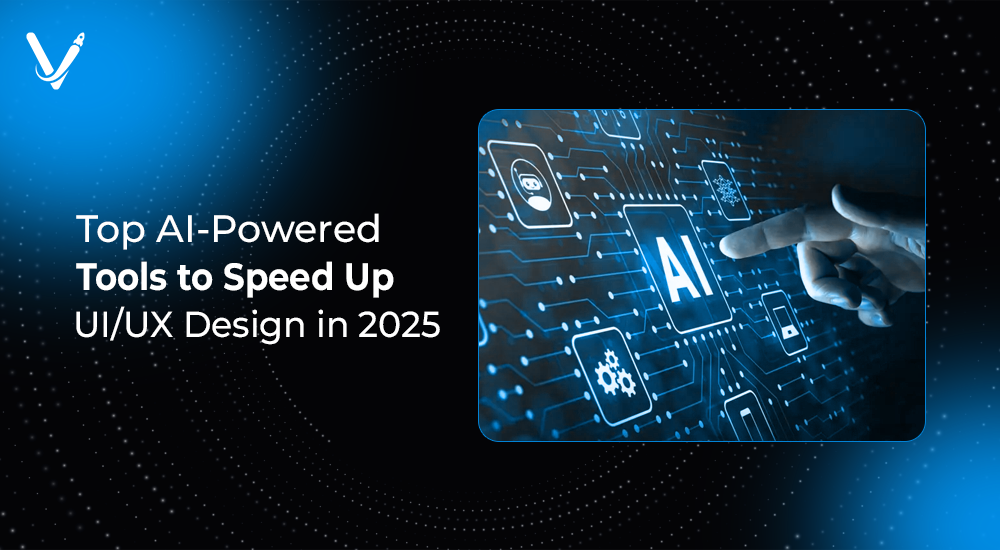Top AI-Powered Tools to Speed Up UI/UX Design in 2025


- Jul 14, 2025



AI has moved beyond the realm of automation into the core of creative problem-solving. In the design world, it is no longer just about accelerating wireframes or generating color palettes. It's about smarter decisions, data-driven prototypes, contextual personalization, and systems that understand user behavior better than ever. As digital experiences grow in complexity and users demand seamless interfaces, designers are turning to AI tools for UX design to gain an edge.
In this blog, we explore the top AI-powered tools shaping the UI/UX landscape in 2025. We dive into how these tools are helping designers iterate faster, create intelligent experiences, and automate repetitive tasks without losing creative control.
AI has increasingly become a silent co-pilot for UX designers. It predicts user behavior, suggests usability improvements, automates layouts, and even helps with voice UX and gesture-based design. The intersection of UX and AI is giving birth to a new role: the AI UX Designer.
Key ways AI is impacting UI/UX in 2025:
Recent studies show that teams using AI UX design tools complete MVP mockups 60% faster than traditional teams. Moreover, 78% of these teams report higher user satisfaction scores due to AI-driven personalization and optimization features. AI in user experience is no longer experimental; it’s essential.
Uizard.io remains one of the most talked-about UI UX AI generator tools. This powerful platform transforms hand-drawn sketches, screenshots, or wireframes into ready-to-edit UI screens.
Features:
Use case: A SaaS startup reduced their design cycle by 70% using Uizard.io to instantly convert low-fidelity sketches into polished UI mockups.
Keywords: Uizard.io, Free AI tools for UI UX design, AI UX Design
Galileo AI leverages natural language processing to turn prompts into high-fidelity designs. Just describe your app’s functionality, and it will generate UI screens with precision.
Benefits:
Galileo AI is popular among freelance designers and startups aiming for rapid prototyping without investing in traditional UX tools.
Keywords: AI UX, Study AI tool, Ai for UX Design
Framer's AI functionality now rivals top website generators by allowing complete site creation with a single prompt.
Why it's powerful:
Framer helps agencies deliver polished web products at scale, minimizing development time and maximizing experimentation.
Keywords: Website generators, AI UX design tools, AI for product design
Figma’s new AI plugins in 2025 have turned the platform into an intelligent assistant. It now suggests layout improvements, identifies accessibility gaps, and auto-generates content based on context.
AI-driven features:
Pro tip: Use the FigGPT plugin to generate onboarding flows or dashboards based on your design system.
Keywords: AI for UX, UX tools, Free AI user interface generator
Relume's AI assistant focuses on layout generation and component mapping using brand style guides.
Unique features:
Ideal for teams maintaining design systems across multi-product environments.
Keywords: Ai UX design, Ai in user experience, Ai and UX
AI tools don’t rely on guesswork. They utilize real-time analytics, A/B test patterns, and historical engagement data to shape design.
Benefits include:
Modern tools automatically evaluate designs for contrast, color blindness, and inclusive language. This ensures your designs serve all users, not just the average ones.
With tools like AI UX design tools, a 2-week design sprint can shrink to 3 days. This pace is game-changing in competitive markets.
Integrating AI early in product development unlocks:
Tools like Uizard.io and Galileo use datasets of successful products to recommend optimal interface patterns.
Designers can now:
This shift transforms designers into curators of intelligent systems, not just pixel pushers.
Many designers begin their journey with no-code and free tools. Here are some standout options:
These tools help in early ideation, especially for startups or freelancers.
Research by UXTools.co shows:
Designers are not being replaced—they’re being augmented. The tools assist in ideation, streamline usability testing, and accelerate the feedback loop.
Learning curves are flattening. Tools now guide junior designers with:
AI and learning go hand in hand, building design intuition faster than ever.
AI isn’t a luxury or trend in 2025—it’s the backbone of efficient design systems. Teams using AI tool for UX design not only create better products but also reclaim time to focus on strategy, storytelling, and innovation. Tools like Uizard.io, Framer, and Galileo prove that automation and creativity are not enemies.
Vasundhara Infotech encourages every designer, founder, or product strategist to start integrating AI into their UX process. Whether you’re building MVPs, e-commerce platforms, or enterprise dashboards, the right UX AI stack will multiply your output and insight.
Contact us to discover how we blend AI and UX to craft engaging digital products for businesses worldwide.
Copyright © 2026 Vasundhara Infotech. All Rights Reserved.